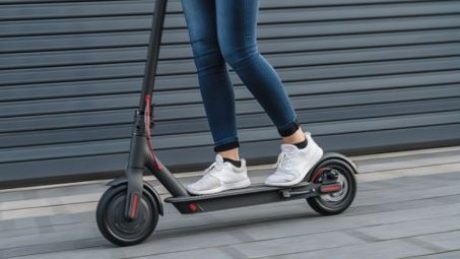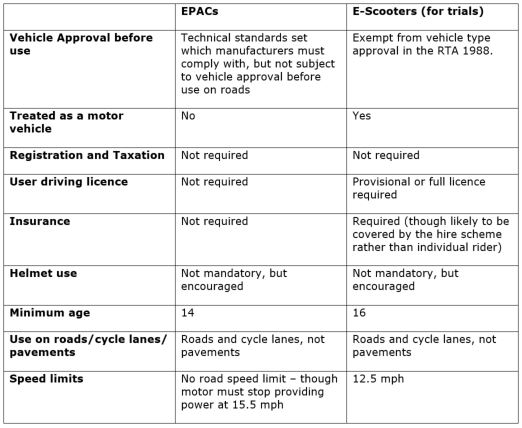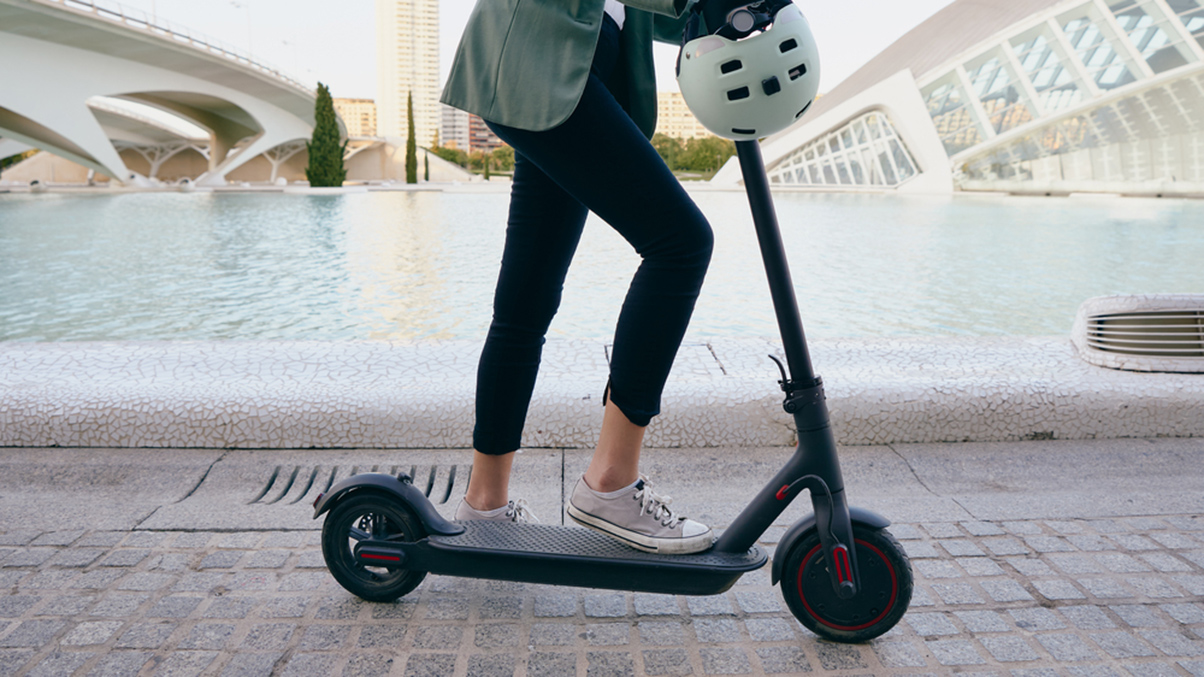The recent Department for Transport consultation on the future of mobility sought views on the proposed introduction and legalisation of e-scooters in the UK. Shortly after the consultation closed, e-scooter trials were brought forward and are now ongoing in limited places in the UK; legalising e-scooter riding in limited scope. Lucie Clinch and Julian Chamberlayne look at the considerations and complexities around the lawful introduction of e-scooters onto our roads.
The current position at home and abroad
In the UK, you can buy e-scooters for personal use, but they cannot be legally ridden on roads, cycle lanes or pavements unless the e-scooter is part of the new trials in which road and cycle lane use is permitted. There are separate rules and regulations for e-bikes (electrically assisted pedal cycles (EAPCs) which do not yet extend to e-scooters, but it is predicted that e-scooters will be regulated in a similar manner.
Different countries have varying levels of regulation around e-scooters, with some already available in various city hire schemes. Not all countries require insurance, for example, or a driving licence. Regimes also differ as to registration, taxation and helmet use, with some requiring a motorcycle type helmet to be worn. The different rules and lack of consistency around the globe suggest e-scooter regulation is not straightforward.
The case studies below provide a sample of how other cities have different approaches to micromobility vehicles regulations:
Berlin, Germany
Germany has regulated to allow ‘small electric vehicles’, which includes electric scooters, to be used. These are limited to 12.5 mph (20km/h) and must have handlebars. Electric scooters must be used on the road or cycle lanes (where available), but not on the pavement. Users must have insurance and the vehicle must be registered, but a driving licence and helmet are not required.
Tel Aviv, Israel
Hireable e-scooters providers are licenced and there is a limit in the number of e-scooters available. Users must be 18 years old and hold a specific driving licence. E-scooters are used in cycle lanes and cannot use the pavement. They must be parked in designated spaces.
Barcelona, Spain
E-scooters can use cycle lanes at speeds up to 10km/h (around 6 mph) and on-road at speeds up to 30km/h (18.6mph) but cannot be used on pavements. They must be parked in designated spaces. The minimum ages to use an e-scooter is 16. Users of e-scooters that are between 25-50kg and commercial users require helmets. Insurance is recommended but not required.
Kyoto, Japan
In Japan, electric scooters are classed as mopeds. Electric scooter users require a driving license, motor insurance and a crash helmet.
Singapore
‘Personal mobility devices’ (which includes electric scooters) are defined with a maximum speed of 25km/h, and maximum sizes and weight. They must be registered and can only be used on cycle paths (not on the road or pedestrian-only paths). Helmets are not compulsory.
How safe are e-scooters?
At present, reliable accident data on e-scooters is limited. However, a study of injuries relating to manual and electric scooter use between January 2016 and July 2019 in Copenhagen is one of the few reviews undertaken. The data, gathered for an article in the BMJ, confirmed that hospitals saw 468 scooter-related injuries. Riders of electric scooters were likely to be 18-25 years old, sustain facial bruising and lacerations requiring sutures, and be under the influence of drugs or alcohol. Non-riders of electric scooters were mostly elderly people tripping over a scooter and sustaining an injury.
The recent consultation acknowledged that “in order to fully understand e-scooter safety, data is required that allows comparison to other modes, such as the number and severity of injuries per number of miles travelled”. This kind of data is some way off, particularly in the UK where e-scooter trials have been brought forward in the absence of any such data, and it will be some time before it is available. At present, the limited studies abroad demonstrate that e-scooters are not risk-free to either riders or pedestrians or other road users. For this reason, we consider some form of driver training is important for both e-scooter riders and other road users.
The benefits of travel on e-scooters
E-scooters can offer a relatively environmentally-friendly method of travel. In addition, they would allow users to travel alone in this time of social distancing, and they would potentially get individuals from A to B quicker than public transport.
E-Scooters and EAPCs
Policy on EAPCs has already been set: EAPCs are not classed as motor vehicles for the purpose of regulation. Given the similarities between EAPCs and e-scooters, together with the fact that the government has acknowledged that it may look to amend the law to treat e-scooters more like EAPCs, it would seem that now is the perfect time to bring these differing strands of legislation together. This would increase consumer confidence and provide clarity as to what rules apply to each type of vehicle.
The minimum age for EAPC use is 14, and no driving licence is required. Nor is insurance or a cycle helmet required (though the latter is encouraged). There is no speed limit, though the electric motor must stop providing power at 15.5mph.
The e-scooter rental rules
As noted above, new guidelines are in force to legalise e-scooters for trials, and two requirements apply to e-scooters (but do not apply to EAPCs):
- E-scooters in trials need to be governed by a motor insurance policy; and
- E-scooter users must have a valid driving licence (or provisional).
It seems likely, however, that the government will aim to provide a separate regulatory regime for e-scooters, which will exclude them from motor vehicle regulation and legislation. In the meantime, insurance will need to be provided by those who are running the trials.
General safety requirements for users in the trials include not using a mobile phone, not carrying more than one person at a time and not driving while intoxicated. The usual rules of careless and dangerous driving apply to e-scooter drivers.
There are distinct areas of difficulty with regard to e-scooter expansion and legalisation beyond the trials. Key areas of debate relate to insurance, registration/tracking and helmet requirements. In considering this debate, we consider e-scooters alongside other micromobility vehicles that will become more widely available over the coming years.
Insurance – e-scooters and micromobility vehicles
With the advent of EAPCs, autonomous vehicles and now e-scooters, it is as important as ever that an appropriate legislative and insurance regime is in place that is appropriate to these vehicle types. The Road Traffic Act 1988 (RTA) has long struggled to keep up with developments in technology and road traffic and needs an overhaul to cater for the new technology on our roads. It is important that legislation is brought rapidly up to date with the new forms of technology for powered vehicles, some of which can reach speeds of over 30mph.
The Motor Insurance Directive (MID) applies throughout Europe and covers any powered [motor] vehicle being used as a means of transport on any type of land, including private land. The case of MIB v Lewis [2019] EWCA Civ 909, confirmed that the Motor Insurance Bureau should meet any claims where the RTA regime is not aligned with the MID, particularly since the decision of the Court of Justice of the European Union in Vnuk (C162/13). The Motor Insurance Bureau should cover any victims of accidents involving uninsured or untraced e-scooters and other micromobility vehicles.
An insurance regime can protect both riders and victims of accidents involving e-scooters. The current trials consider them as ‘motor vehicles’, and it would make sense to continue to do so, rather than to change the law to bring them into line with EAPCs. It would be better be for the fledgling EAPCs regime to be revised so that EAPCs are covered by insurance also. The cost of any such insurance need not be high and can be as a simple add on to standard house or contents insurance for bike/e-scooter owners.
Registration
It seems sensible that if e-scooters are to be more widely available and legalised, registration should be required and each e-scooter should carry a scannable registration mark. Registration schemes could go hand-in-hand with insurance, whereby a registered owner is known and traceable in the event of an incident.
Helmet use
Helmet use has long been a divisive issue between cyclists and non-cyclists. Some would argue against legislating to make helmet use compulsory, as it could discourage people from using the vehicle and limit wider use or take-up among consumers, particularly when considered in a hire scheme context (akin to ‘Boris bikes’).
The recent consultation sought views on treating e-scooters like mopeds, which would require a type of motorcycle helmet. While it may not be necessary to encourage motorcycle helmets for e-scooters, it should be acknowledged that these vehicles can travel at speeds over 12.5-15.5 mph in the right conditions. E-scooters present risks to riders and vulnerable road users akin to pedal cycles, arguably even more risk. For e-scooters that are capable of higher speeds, similar to mopeds, then a motorbike-style helmet should be required.
Other micromobility vehicles
It should not be ignored that e-scooters are not the only new type of vehicle that are starting to be used on our roads (and pavements). The distinction between EPACs and e-scooters seems to be based on whether or not the vehicle has peddles. Does that make such a big difference to the necessary legal and insurance regime?
There are a number of other micromobility vehicles in use, such as electric skateboards, self-balancing vehicles and electrically assisted cycle trailers and yet more are likely to hit the market in the next few years. Legislation should be amended to cater for all kinds of micromobility vehicles, rather than looking at the laws each time a new vehicle is released. If the Motor Insurance Directive is considered alongside the Lewis and Vnuk cases, it is imperative that e-scooters continue to be defined as motor vehicles that require insurance, and that the MIB is responsible for any injuries caused by uninsured or untraced e-scooters and EPAC riders.
You can find further information regarding our expertise, experience and team on our International Injury pages.
If you require assistance from our team, please contact us or alternatively request a call back from one of our lawyers by submitting this form.
Subscribe – In order to receive our news straight to your inbox, subscribe here. Our newsletters are sent no more than once a month.








